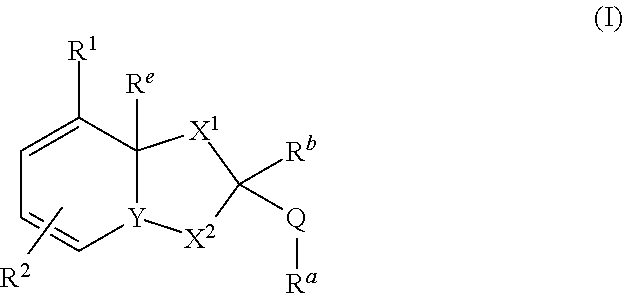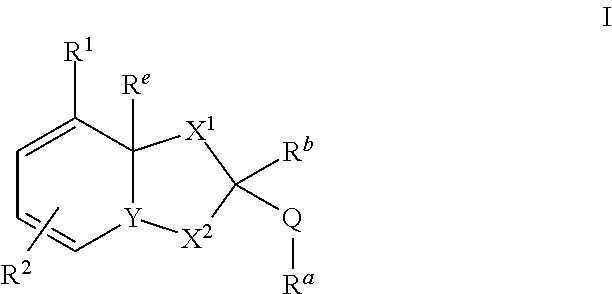Dihydroorotate dehydrogenase inhibitors
a technology of dihydroorotate and inhibitors, which is applied in the direction of biocide, drug composition, immunological disorders, etc., can solve the problems of significant delay in the onset of disease and in the severity of symptoms
- Summary
- Abstract
- Description
- Claims
- Application Information
AI Technical Summary
Benefits of technology
Problems solved by technology
Method used
Image
Examples
example 1
2-Biphenyl-4-yl-1H-benzoimidazole-4-carboxylic acid
[0252]
Step 1: 2-Hydroxyimino-N-(2-nitro-phenyl)-acetamide
[0253]
[0254]A solution of chloral hydrate (29 g, 175 mmol), hydroxylamine hydrochloride (69.4 g, 1000 mmol) and anhydrous sodium sulphate (21 g, 149 mmol) in water (800 mL) was heated to 65° C. To this a suspension, 2-nitroaniline (20 g, 150 mmol) in 2 molar aqueous HCl (20 mL) was added. This mixture was stirred overnight at the same temperature, then cooled to room temperature. The precipitated product was collected by filtration, washed with water dried in a vacuum oven to give 25 g of the required product as a yellow coloured solid (83%).
[0255]1H NMR (300 MHz, DMSO-d6): δ (ppm)=12.62 (s, 1H), 10.94 (s, 1H), 8.29 (d, 1H, J=8.4 Hz), 8.13 (dd, 1H, J=8.4 & 1.2 Hz), 7.77 (m, 1H), 7.62 (s, 1H), 7.36 (m, 1H). HPLC purity: 85%.
Step 2: 7-Nitro-1H-indole-2,3-dione
[0256]
[0257]2-Hydroxyimino-N-(2-nitro-phenyl)-acetamide (15 g, 72 mmol) was carefully added in small portions to a stirre...
example 2
2-(4-Benzyloxy-phenyl)-1H-benzoimidazole-4-carboxylic acid
[0276]
[0277]Example 2 is obtained as described in example 1 but starting from 4-(benzyloxy)benzoic acid (procured commercially from aldrich).
[0278]1H NMR (300 MHz, DMSO-d6): δ (ppm)=8.26 (d, 2H, J=8.7 Hz), 7.94 (dd, 2H, J1=11.4 Hz, J2=11.1 Hz), 7.51-7.35 (m, 6H), 7.26 (d, 2H, J=9 Hz), 5.25 (s, 2H). HPLC purity: 92.44%.
example 3
2-(3-Fluoro-3′-methoxy-biphenyl-4-yl)-1H-benzoimidazole-4-carboxylic acid
[0279]
Step 1: 3-Fluoro-3′-methoxy-4-methyl-biphenyl
[0280]
[0281]A mixture of toluene (22.7 mL) and water (22.7 mL+7.5 mL) was degassed with nitrogen for 30 min. A mixture of cesium carbonate (3.3 g, 1.04 mmol), 4-bromo-2-fluoro-1-methyl-benzene (1.0 g, 5.2 mmol), 3-methoxyphenylboronic acid (0.8 g, 5.2 mmol) and tetrakis triphenyl phosphene palladium (0.294 g, 0.26 mmol) was added to the above degassed aq. toluene and the resulting mixture was refluxed for 5 h. After the reaction was completed, it was cooled and extracted with ethyl acetate. The combined ethyl acetate layers were dried over sodium sulphate and concentrated. The residue was purified by column chromatography using 10% ethyl acetate in hexane to obtain the title compound (0.85 g, 74%).
[0282]1H NMR (300 MHz, CDCl3): δ (ppm)=2.4 (s, 3H), 3.9 (s, 3H), 6.9-7.4 (m, 7H).
Step 2: 4-Bromomethyl-3-fluoro-3′-methoxy-biphenyl
[0283]
[0284]To a solution of 3-fluo...
PUM
| Property | Measurement | Unit |
|---|---|---|
| temperature | aaaaa | aaaaa |
| temperature | aaaaa | aaaaa |
| temperature | aaaaa | aaaaa |
Abstract
Description
Claims
Application Information
 Login to View More
Login to View More - R&D
- Intellectual Property
- Life Sciences
- Materials
- Tech Scout
- Unparalleled Data Quality
- Higher Quality Content
- 60% Fewer Hallucinations
Browse by: Latest US Patents, China's latest patents, Technical Efficacy Thesaurus, Application Domain, Technology Topic, Popular Technical Reports.
© 2025 PatSnap. All rights reserved.Legal|Privacy policy|Modern Slavery Act Transparency Statement|Sitemap|About US| Contact US: help@patsnap.com



